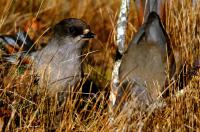
A male Siberian jay eats with his progeny, which makes the young bird's life much safer. With the aid of various alarm calls the Siberian jay bird species tells other members of its group what their main predators-¬hawks¬-are doing. The alarm calls are sufficient for Siberian jays to evince situation-specific fleeing behaviors, which enhances their chances of survival. This discovery, being published by Uppsala University researcher Michael Griesser in the journal Current Biology, shows for the first time that animals can assess and communicate about the behavior of predators.
Many animal species are exposed daily to the risk of being killed by a predator. Certain apes and marmots have developed specific alarm calls that communicate the category of predators or the distance of predators to other group members. It has been proposed that this is an adaptation that helps them survive daily encounters with predators.
“But the risk a predator represents to its prey is also contingent on the behavior of the predator, so it would be an advantage for survival to be able to communicate whether the predators are in hunting mode or are full and contented,” explains Michael Griesser, a researcher at the Department of Ecology and Evolution at Uppsala University.
The findings of the study show that Siberian jays have different alarm calls for hawks that are sitting, searching for prey, or attacking. With the help of a playback experiment in which the scientist played the various alarm calls for Siberian jays, he was able to demonstrate that the alarm call is sufficient to get Siberian jays to evince a situation-specific fleeing behavior.
Upon hearing the call that is given for sitting hawks, they fly up to the tops of trees and look for the hawk. The attack call prompts them to flee to the closest refuge as quickly as possible and then to start to look for the hawk. Playing the call that is given for hawks searching for prey gets the jays to flee to the nearest refuge and stay there without moving, for several minutes, to avoid being discovered by the hawk.
“These findings are astonishing and show for the first time that animals can assess and communicate about the behavior of their predators, and that not only mammals but also birds have developed advanced communication systems,” says Michael Griesser.
An earlier study of Siberian jays showed that parents protect their young but not unrelated group members with their alarm calls and that this extra protection leads to much lower odds that related group members will be taken by a hawk during their first winter. Together with the new study, this shows for the first time that alarm calls actually do enhance the survival of other individuals. Until now this was merely an assumption, even though this is a basic function of alarm calls.
“Since complex communication systems in the animal world were developed primarily in species that live in family groups, it appears that selection based on kinship is an important factor for the development of such systems in the animal world. To be able to save the life of a related animal ultimately serves to further the animal’s own genes. Perhaps this factor was also a key condition for our ancestors, who also lived in family groups, to be able to develop the capacity for language,” says Michael Griesser.
Source : Uppsala University
 Print Article
Print Article Mail to a Friend
Mail to a Friend
